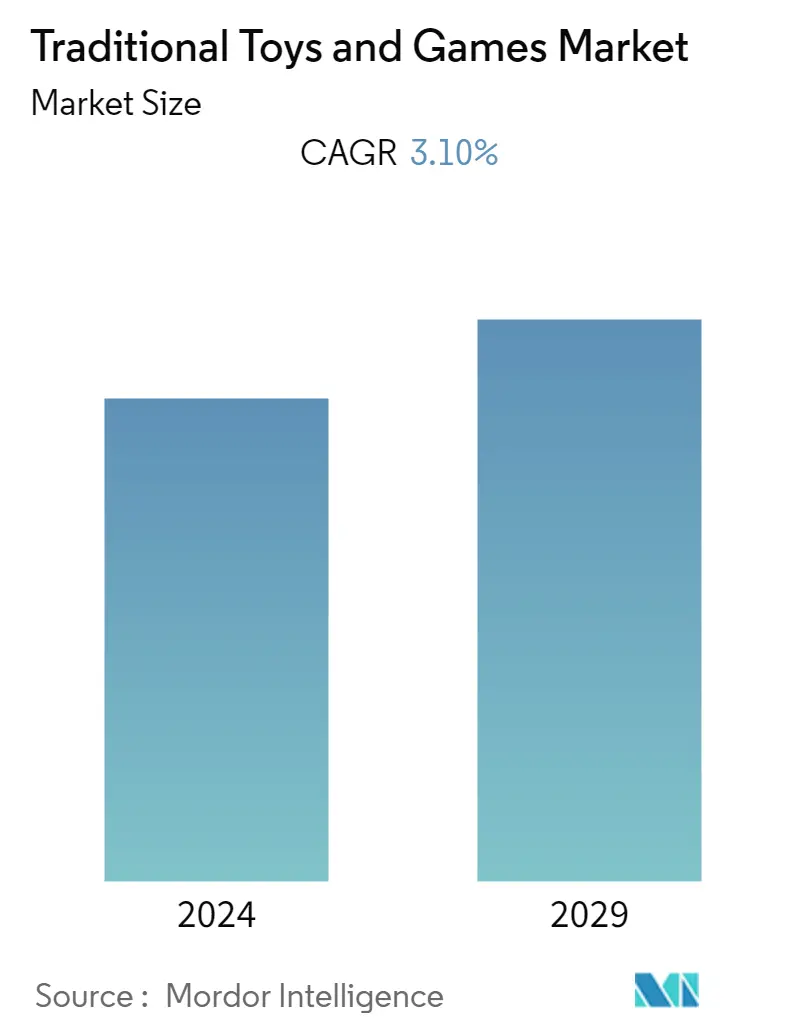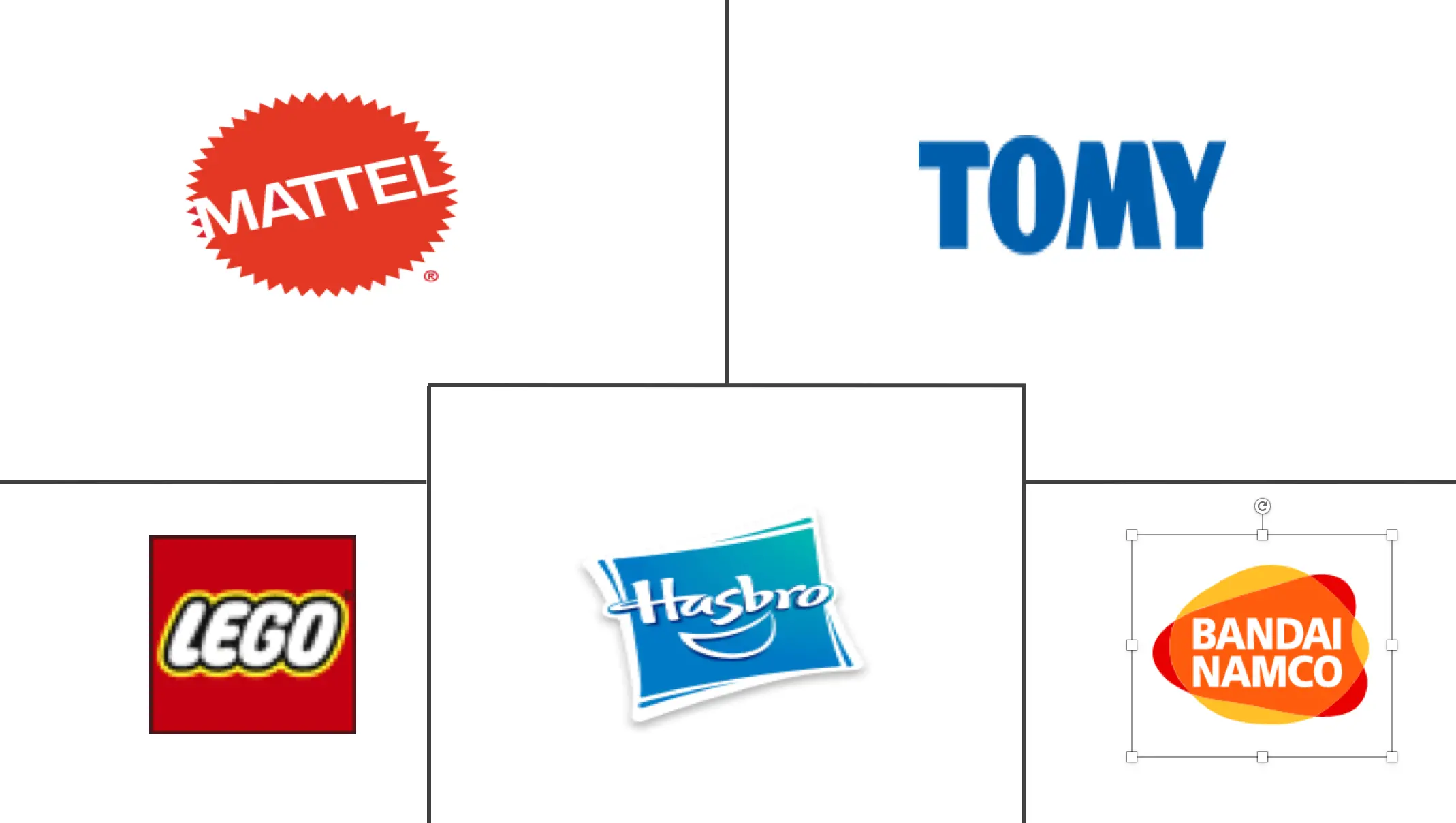Market Size of Traditional Toys and Games Industry

| Study Period | 2019 - 2029 |
| Base Year For Estimation | 2023 |
| CAGR | 3.10 % |
| Fastest Growing Market | South America |
| Largest Market | Asia-Pacific |
| Market Concentration | Low |
Major Players
*Disclaimer: Major Players sorted in no particular order |
Traditional Toys and Games Market Analysis
The Global traditional toys and games market is projected to grow at a CAGR of 3.1% during the forecast period, 2022 - 2027.
As an impact of COVID-19, the market witnessed a strong growth among the high-income and middle-income consumers, leading to the launch of numerous stay-at-home product ranges by the leading players. During the pandemic, toys and games sales were primarily driven by the online retail of products. However, due to delays in much-anticipated movie releases like 'Trolls World Tour' and 'Top Gun: Maverick,' the toys, collectibles, and other merchandise based on the character of these movies that already reached the retailer stores observed no or minimal sales. Thus, it negatively impacted the market growth over the medium term.
The core strategy used by toy manufacturers to attract children is to commercialize favorite movies and cartoon characters such as Spiderman, Ironman, Superman, and Doraemon. Moreover, construction toys are driving the market, as it aids the children in developing their brains and inculcates different learning methods.
Players in traditional toys and games must adapt to the digital era to stay relevant to children. Children are spending more time online, especially on mobile devices, which is expected to restrain the future market studied.
Traditional Toys and Games Industry Segmentation
Toys and games are the tools of play, which hold an important part in social life. These are mainly intended for children's use, though they have also been marketed to adults under certain circumstances. The global traditional toys and games market is segmented by product type as outdoor and sports toys, construction sets, dolls, and plush toys, vehicles, action figures, others. Also, by distribution channel divides the market into hypermarkets/supermarkets, specialty retail stores, and online retail stores. The market is segmented based on geography: North America, Europe, Asia-Pacific, South America, and Middle-East and Africa. For each segment, the market sizing and forecasts have been done based on value (in USD billion).
| By Product Type | |
| Outdoor and Sports Toys | |
| Construction Sets | |
| Dolls and Plush Toys | |
| Vehicles | |
| Action Figures | |
| Others |
| By Distribution Channel | |
| Hypermarket/Supermarket | |
| Speciality Retail Stores | |
| Online Retail Stores | |
| Others |
| Geography | |||||||||
| |||||||||
| |||||||||
| |||||||||
| |||||||||
|
Traditional Toys and Games Market Size Summary
The traditional toys and games market is experiencing a steady growth trajectory, driven by various factors including the increasing focus on child development and the rising disposable incomes in regions like Asia-Pacific. The market has seen a shift towards online retail, especially during the COVID-19 pandemic, which spurred the launch of stay-at-home product ranges. However, delays in movie releases have impacted the sales of related merchandise. Manufacturers are leveraging popular movie and cartoon characters to attract children, while construction toys are gaining traction for their cognitive benefits. Despite the digital shift, there is a growing demand for outdoor, sports, and educational toys, as parents and educators prioritize physical activity and skill development to combat childhood obesity and enhance cognitive abilities.
In the Asia-Pacific region, the abolition of the one-child policy in China has contributed to a rise in the child population, further fueling market growth. The increasing number of middle-class families and retail outlets is also boosting demand for toys and games. Key players like Hasbro, LEGO, and Mattel are focusing on innovation and safety in their product offerings, with a keen interest in art-based, science, and technology-related toys. The market is expected to benefit from the growing interest in educational toys, as parents and educators seek to develop children's skills through engaging and interactive products. This trend is anticipated to create lucrative opportunities for the traditional toys and games market in the coming years.
Traditional Toys and Games Market Size - Table of Contents
-
1. MARKET DYNAMICS
-
1.1 Market Drivers
-
1.2 Market Restraints
-
1.3 Porter's Five Forces Analysis
-
1.3.1 Threat of New Entrants
-
1.3.2 Bargaining Power of Buyers/Consumers
-
1.3.3 Bargaining Power of Suppliers
-
1.3.4 Threat of Substitute Products
-
1.3.5 Intensity of Competitive Rivalry
-
-
-
2. MARKET SEGMENTATION
-
2.1 By Product Type
-
2.1.1 Outdoor and Sports Toys
-
2.1.2 Construction Sets
-
2.1.3 Dolls and Plush Toys
-
2.1.4 Vehicles
-
2.1.5 Action Figures
-
2.1.6 Others
-
-
2.2 By Distribution Channel
-
2.2.1 Hypermarket/Supermarket
-
2.2.2 Speciality Retail Stores
-
2.2.3 Online Retail Stores
-
2.2.4 Others
-
-
2.3 Geography
-
2.3.1 North America
-
2.3.1.1 United States
-
2.3.1.2 Canada
-
2.3.1.3 Mexico
-
2.3.1.4 Rest of North America
-
-
2.3.2 Europe
-
2.3.2.1 Spain
-
2.3.2.2 United Kingdom
-
2.3.2.3 Germany
-
2.3.2.4 France
-
2.3.2.5 Italy
-
2.3.2.6 Russia
-
2.3.2.7 Rest of Europe
-
-
2.3.3 Asia-Pacific
-
2.3.3.1 China
-
2.3.3.2 Japan
-
2.3.3.3 India
-
2.3.3.4 Australia
-
2.3.3.5 Rest of Asia-Pacific
-
-
2.3.4 South America
-
2.3.4.1 Brazil
-
2.3.4.2 Argentina
-
2.3.4.3 Rest of South America
-
-
2.3.5 Middle-East and Africa
-
2.3.5.1 South Africa
-
2.3.5.2 Saudi Arabia
-
2.3.5.3 Rest of Middle-East and Africa
-
-
-
Traditional Toys and Games Market Size FAQs
What is the current Traditional Toys and Games Market size?
The Traditional Toys and Games Market is projected to register a CAGR of 3.10% during the forecast period (2024-2029)
Who are the key players in Traditional Toys and Games Market?
TOMY, Kirkbi A/S (LEGO System A/S), BANDAI NAMCO Holdings.Inc, Mattel and Hasbro are the major companies operating in the Traditional Toys and Games Market.

